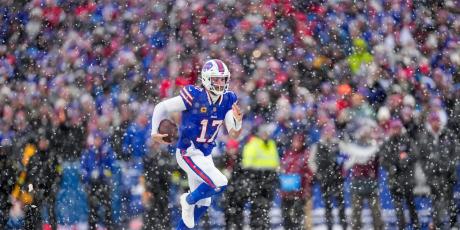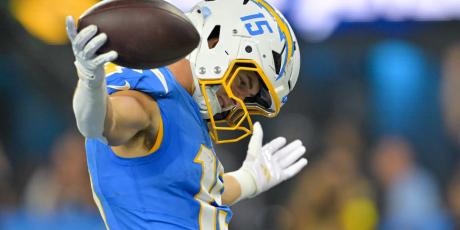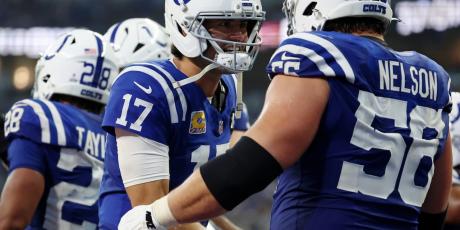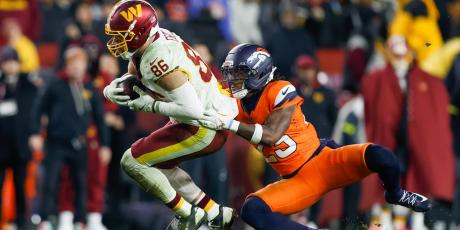How to Pinpoint Fantasy Football Sleepers
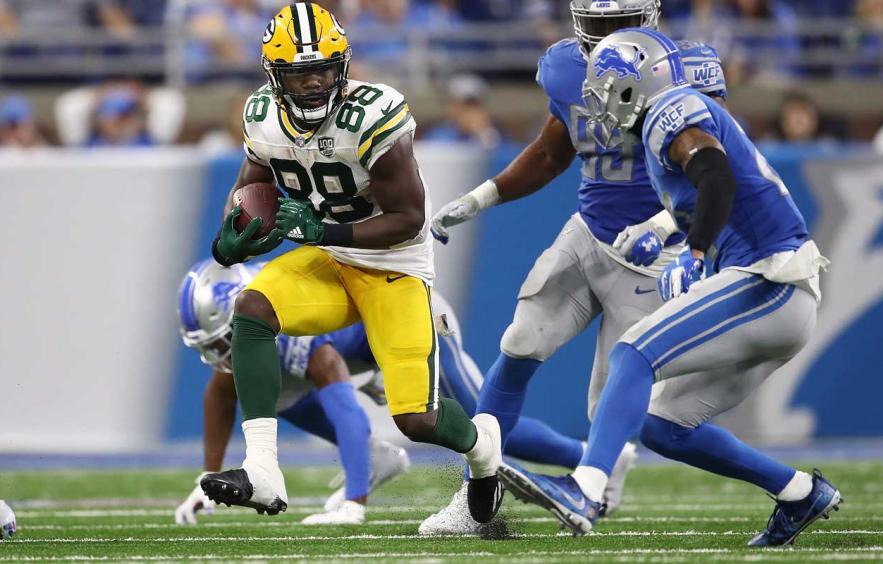
Sleepers. We all love them, but how do you find them?
It requires a disciplined approach, with an ability to use information and statistics and not coach speak from OTAs, training camp smokescreens, and Twitter practice videos to form opinions on players.
Our goal is to find players our league mates pass over because they have ignored critical information that illustrates an opportunity to produce.
Finding sleepers is about evaluating risk. How much risk you can stomach should be a direct correlation to draft round. The deeper you go into a fantasy draft, the more tolerance you should have for a player with a low floor. But always focus more on how high the ceiling is for that player.
Below I go over some of the best practices for pinpointing sleepers.
Ranking Versus Average Draft Position
You simply cannot find sleepers without studying the nexus of trusted rankings and average draft position (ADP). Without a cross-comparison of the two, you are exercising the fantasy football equivalent of throwing darts. A great place to start is with 4for4's rankings.
Once you have your rankings, make sure you also include the latest ADP on each player in those rankings. 4for4’s rankings already do this for you with a column on the far right side of each rankings page indicating their ADP in both 10- and 12-team leagues.
Often, you’ll find the highest-ranked players at each position fall pretty close to their ADP, but the deeper you get into drafts, a handful of names begin to creep up your rankings ahead of their ADP. For example, in PPR leagues, Packers wide receiver Randall Cobb has an ADP in the ninth round; however, he is the No. 26 ranked WR in 4for4’s PPR rankings, ahead of a handful of wideouts with earlier ADPs. If you wait to select Cobb based on his ADP, it will allow you to target other positions of need in earlier rounds, thereby making your overall roster stronger.
Finding sleepers effectively is not possible without trusted rankings and ADP.
4for4’s ADP Bargains Tool
You can even go a step further and cross-reference ADP from the site that hosts your fantasy league with 4for4 rankings by utilizing our ADP Bargains Tool. This tool allows you to customize your league’s starting lineup settings, scoring settings, and you can customize it according to the site your league is hosted on.
By choosing your ADP source (CBS, ESPN, Yahoo!, DRAFT, FFPC, MFL10, and NFL.com), you can find sleepers based on our rankings and only the ADP from your league site.
For example, if you play in a one-quarterback, PPR league on ESPN that starts 2WR, 2RB, and a FLEX, you will find Patriots RB Rex Burkhead is our number one sleeper, with a 4for4 ranking 82 spots higher than his current ESPN ADP.
Bounce Back Candidates: Why Did They Have a Poor Season?
Often sleepers are players who had poor seasons the year before, which results in other teams in your league passing on them because they no longer trust them. However, it is important to know why that player had a poor season. Looking at their stat line isn’t enough.
Larry Fitzgerald is perennially undervalued. In 2014, Fitzgerald had the worst fantasy season of his career (63-784-2), but it wasn’t his fault. That resulted in Fitzgerald being the 29th receiver, on average, selected in 2015 drafts. In a lot of 12-team leagues, he was still on the board in the eighth round. Drafters completely ignored the fact that Fitzgerald’s quarterbacks for 10 games in 2014 were Drew Stanton, Ryan Lindley, and Logan Thomas. Those that looked beyond the box score, as 4for4 did, were richly rewarded by Fitzgerald’s 2015 season, where he finished as the WR7 in PPR leagues.
Sometimes drafters ignore a player coming off a good season altogether. Michael Crabtree was the 38th WR off the board in MFL10 drafts in 2016, after an 85-922-9 first season in Oakland. Crabtree went on to finish as the WR12 in 2016. Last season, the prime example was … wait for it … Larry Fitzgerald! Coming off a top-10 season in 2016, Fitzgerald was drafted in the middle rounds. And this season? He's being drafted in the fourth round, despite finishing as the WR4.
Another pitfall in pinpointing sleepers is ignoring talent and opportunity, instead emphasizing a season cut short by injury. Use the 4for4 Fantasy Points Browser to see if there are any players in the Ft Pts/G column that are slipping through the ADP cracks.
Carson Wentz averaged more than 21 points per game last year, third at his position, but he’s sixth off the board among quarterbacks in the middle rounds. There’s a potential value there with overall QB1 upside. Philip Rivers is the 15th QB off the board in drafts this year, but he finished 10th in Ft Pts/G last year.
Among RBs, Chris Thompson is a great example of an injured player being written off after his season was cut short by injury, despite being the fantasy RB11 in PPR last year in Ft Pts/G. If rookie Derrius Guice doesn’t show solid pass-catching ability, Thompson could be a great value in the seventh or eighth round.
Among WRs, Emmanuel Sanders is around the 35th WR taken in drafts this summer, despite absurdly poor quarterback play last year. Across the board, Case Keenum is an upgrade from what Denver trotted out under center last year. This could be a similar situation to what we saw with Larry Fitzgerald in 2014-2015. It’s easy to forget Sanders was the WR19 in back-to-back seasons before 2017.
Passing on Sleepers
It is okay to pass on players labeled as sleepers when they are coming off multiple healthy seasons that didn’t meet expectations? In those cases, those touting the sleepers are blindly lobbying a return to glory days while ignoring real data.
Prime historic example: Trent Richardson. Some were touting him as a sleeper in 2014, with a sixth/seventh round ADP. The reasoning by many was that it would be his first full season with the Colts, after getting traded midseason from the Browns in 2013. He supposedly had a full grasp of the offense by then. Maybe that was true, but that’s not real data, is it?
Real data was Richardson averaging only 3.9 yards per carry as a rookie, regressing to 3.4 yards per carry in Cleveland the next season, and then dropping all the way down to 2.9 yards per carry after the trade in Indianapolis. The results? A pitiful 3.3 yards-per-carry average in his first (and final) full season with the Colts. If the argument for a sleeper is more subjective than objective, it’s probably best to pass.
Amari Cooper is being touted as a WR1 sleeper by some this season with his ADP in the fourth or fifth round. I just don't see it. He has finished with fewer than 70 yards or no touchdown in 52 percent of weeks in his three-year career. Fantasy football is a weekly game. That is an absolute setting lineups nightmare, and the Raiders appear poised to go with more of a ball-control offense under Jon Gruden.
Beware of players like Richardson, who could lose volume due to a large sample size of inefficiency, and Cooper, who are far too inconsistent to roster with confidence outside of best-ball leagues.
Who is the Offensive Coordinator/Playcaller?
Sometimes with sleepers, we have less objective data to go by with the player himself but more objective data to go by with the past results of his offensive coordinator.
Before the 2016 season, 4for4’s TJ Hernandez studied what Hue Jackson’s move to the Browns would mean for fantasy. He noted: “Over the last 10 seasons, only three active playcallers have averaged a higher percentage of run plays called than Jackson, and no coach has been more consistent in their pass/run splits over that span.”
Valuable information that could have allowed you to scoop up Isaiah Crowell in the 11th round ahead of his RB14 finish in PPR leagues in 2016.
Ahead of the 2015 season, Hernandez studied what new Jets offensive coordinator Chan Gailey would mean to his weapons. What he found for running backs was interesting: Even in Gailey’s last three years as a playcaller, when his top running back only received 56.3 percent of backfield touches, Gailey’s main back still averaged 14.9 PPR FPs/G over his last four seasons, with two of those seasons resulting in RB1 finishes in terms of FPs/G.
Savvy drafters knew this meant a great opportunity for Chris Ivory, with an ADP in the eighth round of 12-team leagues in 2015 drafts. Ivory finished as the RB9 in standard leagues and RB12 in PPR leagues, averaging 13.5 PPR FPs/G.
Be sure to monitor the impact certain playcallers will have in 2018 by checking out TJ’s work.
Patience During the Season
Pinpointing sleepers is also about being patient. If you studied enough to draft a player, why would you drop him before the start of the season or a couple weeks into it before your starters have a bye week?
How many people drafted Odell Beckham Jr. as a rookie only to drop him before he played a down in the NFL after he missed the first four games due to injury? How many of those people then watched another team win a fantasy championship with Beckham?
Did you drop Jay Ajayi in 2016 after he was inactive Week 1, despite all the signs that Arian Foster would not stay healthy and Miami had no other viable early-down backs?
How many dropped Alvin Kamara last year because of Adrian Peterson’s presence in New Orleans, despite countless early season reports that Peterson was not fitting into the offense?
Is some of this hindsight? Yes, but those that don’t learn from history are doomed to repeat it.
Quarterbacks: Past Success in the System
One poor season does not make a career. Ask people who passed on Cam Newton in the seventh/eighth round of 2015 drafts, as the 10th quarterback off the board, before Newton became the top fantasy quarterback that season.
You can find a more in-depth look at year-to-year fantasy consistency for quarterbacks here.
Running Backs: No Established Incumbent Starter in Good Offense
In the middle-to-late rounds of drafts, people often draft a bigger name running back in a committee over a less sexy name that presents more value.
The 2010 Houston Texas is a perfect example. Arian Foster’s ADP finished in the sixth round of 12-team leagues, but I promise you that was skewed by late drafters. It was even lower for weeks, despite reports that he won the starting job in training camp and the preseason over Steve Slaton and Derrick Ward. Foster went on to rush for more than 1,600 yards. Could we have predicted that many yards? Of course not, but we do know you don’t even have a chance if you aren’t the starter.
You’ll find some of the other names drafted ahead of Foster in 2010 interesting. C.J. Spiller—a rookie who wasn’t the starter and rushed for 283 yards and zero touchdowns. Ronnie Brown—who was splitting touches with Ricky Williams. Jonathan Stewart—who was in a three-person committee at the time with Mike Goodson and DeAngelo Williams. Beanie Wells was drafted almost two rounds earlier than Foster that season; he was on the wrong side of a timeshare with Tim Hightower.
In 2018, keep an eye on the Packers and Colts backfields. All of the RBs in those two backfields are being drafted late and both offenses are poised to put up big numbers with Aaron Rodgers and Andrew Luck back. Every back in those offenses, if given the opportunity, has top-15 RB upside.
Running Backs: Can He Catch?
In PPR leagues, an obvious but sometimes overlooked way to pinpoint running back sleepers is simply asking yourself if that back is utilized in the passing attack.
4for4’s 2017 PPR draft rankings illustrated this perfectly for running backs. Marshawn Lynch was reportedly only going to see around 200 carries last season but was still being drafted in the third round, multiple rounds ahead of very capable pass-catching running backs. Lynch did not finish last season ahead of Tevin Coleman, Jerick McKinnon, or Dion Lewis, and he was only slightly better than backs like Theo Riddick, Gio Bernard, Chris Thompson, and Tarik Cohen, who were drafted far later.
In 2018, Duke Johnson could emerge to be this year’s Chris Thompson. He was fourth among RBs in targets last season, should get improved QB play in Cleveland, and is being drafted after the seventh round. TJ Hernadez also agrees that Johnson is the best value in this backfield, due to what he sees from new offensive coordinator Todd Haley.
Wide Receivers: Fantasy Points Per Touch/Target
4for4 Director of Forecasting John Paulsen annually pinpoints breakout receivers using advanced statistics. He is fond of fantasy points per target and with good reason. If a receiver is productive in limited snaps, it’s logical to assume he’ll be productive with more snaps.
That has been backed up by results in previous years. Paulsen wrote:
“...I featured Alshon Jeffery in the 2013 edition of this article. He posted a solid 1.14 FP/T (#37 in the league) on 48 targets during his injury-plagued rookie season. In his sophomore campaign he posted 1.24 FP/T on 149 targets, resulting in a #9 finish at his position.”
“In 2014, Golden Tate was the best example of a productive receiver who turned an increase in targets into a stellar fantasy season. As he joined the Lions, his targets jumped from 99 to 143, while his FP/T stayed relatively steady (1.21 in 2013, 1.10 in 2014). The result was a #13 finish at his position in standard formats.”
I also like to look at fantasy points per target. Who is most taking advantage of when the ball comes their way? One name I really have my eye on in 2018 is Chiefs WRW Sammy Watkins, who is finally fully healthy and spending an entire offseason with an exciting offense in Kansas City. Watkins was seventh in the NFL last season with 2.09 PPR points per target. He is often available after the sixth round. Chargers WR Tyrell Williams is another name I like deep in drafts this year with Hunter Henry out for the year. Williams was 10th in fantasy points per target last season.
| Player | Team | PPR Pts | Targets | FP/T |
|---|---|---|---|---|
| JuJu Smith-Schuster | PIT | 191.7 | 79 | 2.426582278 |
| Ted Ginn | NO | 159.6 | 70 | 2.28 |
| Tyreek Hill | KC | 239.2 | 105 | 2.278095238 |
| Will Fuller | HOU | 113.2 | 50 | 2.264 |
| Marvin Jones | DET | 225.1 | 107 | 2.103738318 |
| Sammy Watkins | KC | 146.3 | 70 | 2.09 |
| Stefon Diggs | MIN | 198.2 | 95 | 2.086315789 |
| Cordarrelle Patterson | NE | 86 | 42 | 2.047619048 |
| Tyrell Williams | LAC | 137.8 | 69 | 1.997101449 |
| Nelson Agholor | PHI | 187.5 | 95 | 1.973684211 |
| Kenny Golladay | DET | 94.6 | 48 | 1.970833333 |
| Ryan Grant | IND | 126.3 | 65 | 1.943076923 |
| Paul Richardson | WAS | 150.3 | 78 | 1.926923077 |
| Brandin Cooks | LAR | 219.2 | 114 | 1.922807018 |
| Robert Woods | LAR | 163.3 | 85 | 1.921176471 |
| Travis Benjamin | LAC | 124.3 | 65 | 1.912307692 |
| Doug Baldwin | SEA | 221.3 | 116 | 1.907758621 |
| Antonio Brown | PIT | 308.3 | 162 | 1.90308642 |
| Albert Wilson | MIA | 116 | 61 | 1.901639344 |
| Davante Adams | GB | 222.5 | 118 | 1.88559322 |
| Cooper Kupp | LAR | 176.9 | 94 | 1.881914894 |
| Chris Hogan | NE | 109.6 | 59 | 1.857627119 |
| Golden Tate | DET | 222.5 | 120 | 1.854166667 |
| Mohamed Sanu | ATL | 174.3 | 96 | 1.815625 |
Wide Receivers: Beware of Rookie Receivers
2017: Corey Davis, Mike Williams, John Ross, Zay Jones, Curtis Samuel
2016: Corey Coleman, Will Fuller, Josh Doctson, Laquon Treadwell, Tyler Boyd
2015: Kevin White, DeVante Parker, Nelson Agholor, Breshad Perriman, Phillip Dorsett, Devin Smith, Dorial Green-Beckham, Devin Funchess
All the WRs listed above were drafted in the first two rounds of the NFL Draft. All were fantasy busts as rookies. You are far more likely to draft a bust than find a sleeper among rookie WRs. The 2018 rookie WR class is also not expected to be a strong one.
Bottom Line
There are many ways to pinpoint sleepers in fantasy football drafts. Here are the best practices:
- Use 4for4 rankings to cross-reference ADP.
- Use objective data, not subjective information.
- If coming off a bad season, evaluate if it was the player’s fault.
- Does the player have more past success than recent failure?
- RBs: Find the pass-catchers.
- WRs: Emphasize fantasy points per target/touch and beware of rookies.
Photo by Gregory Shamus/Getty Images.
Related Articles









